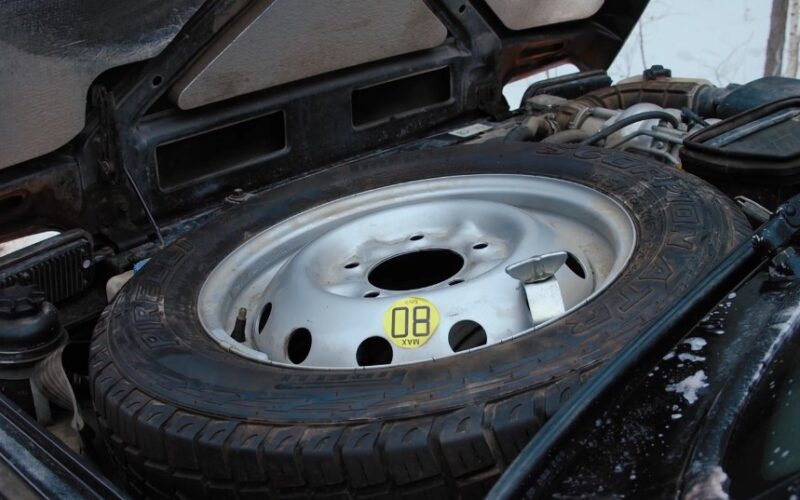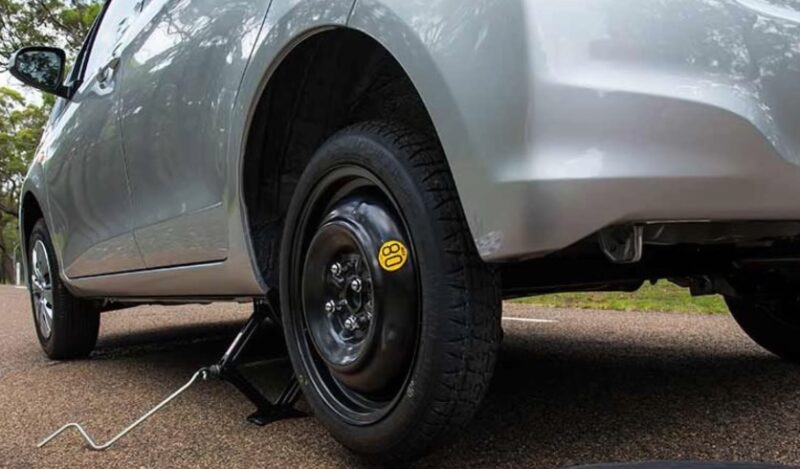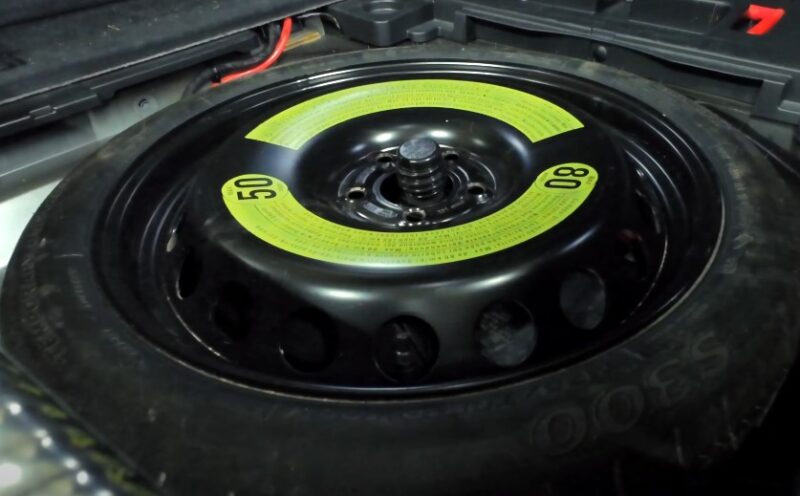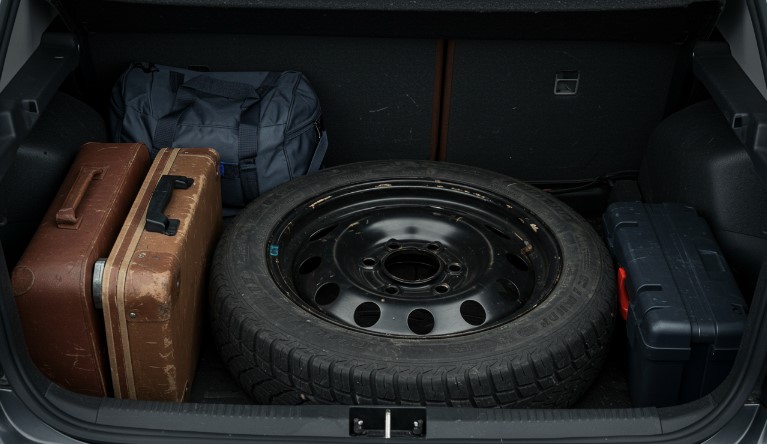There’s nothing quite like that sinking feeling when a tire blows out on the highway. You hear the thump-thump-thump, feel the wobble in the steering wheel, and know instantly – you’ve got a flat.
In that moment, one question matters more than anything: Do I have a spare? But beyond the practical concern, there’s a legal one that’s been popping up more lately: Am I required by law to carry a spare tire?
The answer might surprise you. Let’s break down what the law actually says, what your car might be missing without you even realizing it, and why spare tires are quietly disappearing from the American auto landscape.
What Federal Law Says About Spare Tires

Let’s start at the top: federal regulations. The National Highway Traffic Safety Administration (NHTSA) sets the rules when it comes to vehicle safety standards in the U.S. But here’s the kicker – they do not require vehicles to come with a spare tire.
According to an official NHTSA interpretation dating back to 1979 (and still in effect), the agency clearly stated: “This agency does not currently require that a motor vehicle be equipped with a spare tire.” That’s not an oversight. It’s by design.
NHTSA regulations focus heavily on the safety and performance of the tires you actually drive on – things like tread depth, tire pressure standards, and load ratings, all governed under Federal Motor Vehicle Safety Standard (FMVSS) No. 110.
But nothing in the code mandates a backup. In other words, if your new car rolls off the lot with no spare in the trunk, that’s perfectly legal.
What About State Laws?
Here’s where things get a little more granular. While the federal government doesn’t require spare tires, states can impose their own rules. But so far, only one state has taken that step.
Maryland’s Spare Tire Requirement
Since 1980, Maryland has had a law on the books that addresses spare tires on new vehicles.
As of the latest version of the Maryland Transportation Code § 22-405.3 (2024), any new Class A (passenger) or Class M (multipurpose) vehicle sold in the state must be equipped with one of the following:
- A conforming spare tire that meets state standards.
- Run-flat tires, which allow limited driving after a puncture.
- A factory-installed tire repair and inflation system.
- Or a technological equivalent that meets federal safety standards.
So if you’re buying a new car in Maryland, you’re not legally required to get a traditional spare tire, but your vehicle must be equipped with some form of tire-failure solution.
No exemptions exist for used vehicles or cars registered out of state. Other than Maryland, no other state has a law on the books that mandates spare tires.
That includes big driving states like Texas, Illinois, and Georgia. Still, those states do encourage carrying one for safety.
Why New Cars Are Losing Their Spares
You might assume every vehicle still comes with a backup tire tucked under the trunk mat. But as it turns out, that’s no longer the norm.
According to AAA, nearly 1 in 3 new cars sold in 2022 didn’t include a spare tire. That’s up from just 5% in 2006.
The trend has accelerated in recent years, with Consumer Reports noting that:
- Only about 10% of new vehicles now come with a full-sized spare.
- Roughly 50% have a temporary “donut” spare.
- The remaining 40%? They’re shipped with run-flat tires, tire sealant kits, or nothing at all.
Why the big shift?
Automakers Have a Few Key Reasons:
| Reason | Explanation |
| Fuel Efficiency | Removing a 30-50 lb spare tire setup helps meet federal fuel economy goals. |
| Cost Savings | Cutting the spare saves manufacturers several hundred dollars per vehicle. |
| Space Constraints | Hybrids and compact cars often lack storage room for a full-size spare. |
| Technology Alternatives | Run-flat tires and sealant kits provide a space-saving backup solution. |
What You Might Have Instead

So if you pop the trunk and there’s no spare – what is there? Here’s a breakdown of what might be riding along with you:
| Option | Description | Pros | Cons |
| Full-Sized Spare | Matches the rest of your tires exactly. | No speed/distance limits; good for long-term use. | Heavy; takes up a lot of trunk space. |
| Temporary “Donut” | Smaller, lighter, designed for limited use. | Compact; easy to store. | Limited to 50 miles and 50 mph; poor handling. |
| Run-Flat Tires | Reinforced sidewalls keep the tire usable after a puncture. | No need to stop immediately after a flat. | Expensive; rougher ride; often can’t be repaired. |
| Sealant Kit | Plug + pump combo that seals small punctures. | Lightweight; easy to use. | Doesn’t work on big holes or sidewall damage. |
| Self-Sealing Tires | Sealant-coated tires close over small punctures automatically. | Seamless; no action needed for minor flats. | Limited to specific vehicle types; pricey. |
A donut spare can only get you so far. And if you don’t realize you have run-flats, you might find yourself in trouble when you try to patch or replace them on the roadside.
Why You Still Need a Spare (Even If You’re Not Legally Required To)
Let’s talk real-world consequences. Every year in the U.S., an estimated 220 million flat tires occur. That’s about seven every second.
And according to AAA, in 2017 alone they helped more than 450,000 stranded members who didn’t have a spare. So what happens if you’re one of those drivers?
Three key reasons to carry a spare:
- Safety: Getting stuck on a freeway shoulder or back road at night is more than inconvenient. It can be dangerous.
- Convenience: Waiting hours for a tow, then paying a premium just to fix a basic flat? That adds up.
- Preparedness: If you live in a rural area or like to go off the grid, not having a spare could leave you walking miles for help.
Even in the city, a flat during rush hour can mess with your whole day – or worse, put you in harm’s way if help is delayed.
Checking Your Setup & What Drivers Should Do
View this post on Instagram
With spares no longer a given, here’s what smart drivers are doing:
1. Check Before You Buy
If you’re buying a new or used car, ask the dealer outright:
- Does it come with a spare tire?
- If not, does it have run-flat tires or a repair kit?
Open the trunk. Read the manual. Don’t assume it’s there.
2. Buy a Spare If You Don’t Have One
For cars without a spare, some manufacturers sell spare tire kits you can purchase separately. Prices typically range from $300 to $600, depending on your make and model.
Sealant kits can cost up to $300, and they often expire after 4 to 8 years – so replacing them down the line adds another cost.
3. Maintain Your Spare Tire
A spare tire can go flat while sitting in the trunk for years. Check its pressure at least once a month. Tires also age, even unused, so watch for signs of dry rot or cracking.
4. Learn to Change a Tire
You don’t need to be a mechanic. Just know the basics:
- Where the jack points are
- How to safely loosen and tighten lug nuts
- When it’s safe to drive on a donut
A 2025 survey from AutoInsurance.com found that:
- 57% of drivers who know how to change a tire have done it themselves.
- 26% don’t know how to do it at all.
Learning now might spare you a much bigger headache later.
A Quick Word for Off-Roaders and Long-Distance Drivers

If you’re towing, trail riding, or driving through remote areas, carrying a full-sized spare is a no-brainer. In some cases, even having two spares isn’t overkill – especially for large trucks or RVs with specialized tires.
Lug pattern and size mismatches are common across trims. So make sure your spare actually fits your specific vehicle, not just the brand or model.
What About Europe?
While U.S. laws on spare tires are relatively relaxed – Maryland being the only exception – European countries often approach the issue differently, especially when it comes to what drivers are expected to carry in their cars.
Most European nations do not have national laws explicitly requiring a spare tire, but the expectations on drivers are often higher.
In practice, many countries require drivers to carry basic emergency equipment that allows them to deal with a breakdown safely, and that can include tools related to tire repair or replacement.
Austria – Practical Requirements, Not Strict Laws
Take Austria, for example. There’s no hard law that says every vehicle must carry a spare tire. However, Austrian road regulations do require that vehicles be “roadworthy and properly equipped” for emergencies.
Here’s what’s typically expected of drivers in Austria:
- A first-aid kit
- A warning triangle
- A reflective vest
- And in some interpretations – the ability to continue driving safely after a flat tire
That last part is key. If your car doesn’t have a spare tire, it must have either:
- Run-flat tires
- Or a functional tire repair kit
Tip: If you’re equipping your vehicle for Austrian road inspections, a trusted option like the Hubtrac tire ensures you’re not cutting corners on safety.
Failure to have some way to address a flat could result in fines during roadside inspections, especially if you’re blocking traffic or causing a hazard due to being unprepared.
So while Austria, like the U.S., doesn’t technically mandate a spare tire, the burden of preparedness is more strongly emphasized – and enforced.
It’s about having something in the vehicle that lets you manage a flat on your own, not just relying on towing or assistance.
Broader European Norms

Other European countries follow a similar line:
- Germany: No specific law requiring a spare, but vehicles must be equipped to stay mobile and avoid posing risks.
- France: No spare required, but safety kits (vests, triangles) are mandatory. Not having a way to deal with a tire failure could lead to complications if stopped by police.
- Italy: Again, no direct requirement, but run-flats or sealant kits are considered acceptable substitutes. Police may check during roadside inspections.
In short, Europe leans on the side of safety preparedness, not strict tire laws. Drivers are expected to be ready – not just with lights and brakes – but with equipment to handle basic failures like a flat tire.
Final Thoughts
So, is it illegal to drive without a spare tire in the U.S.? No, not under federal law. And only Maryland requires a spare – or an equivalent – on new vehicles sold in the state.
Still, as automakers continue to cut costs and save space, spares are quietly disappearing. One in three new vehicles no longer has one, and more drivers are finding themselves stranded without a plan.
If your car doesn’t come with a spare, consider adding one. If you’ve got a donut, check the pressure. And if you don’t know how to swap it in, take 10 minutes on a Sunday and teach yourself. It’s not about being paranoid.
It’s about being ready. Because when that tire blows and the hazard lights come on, you’ll be glad you thought ahead.






